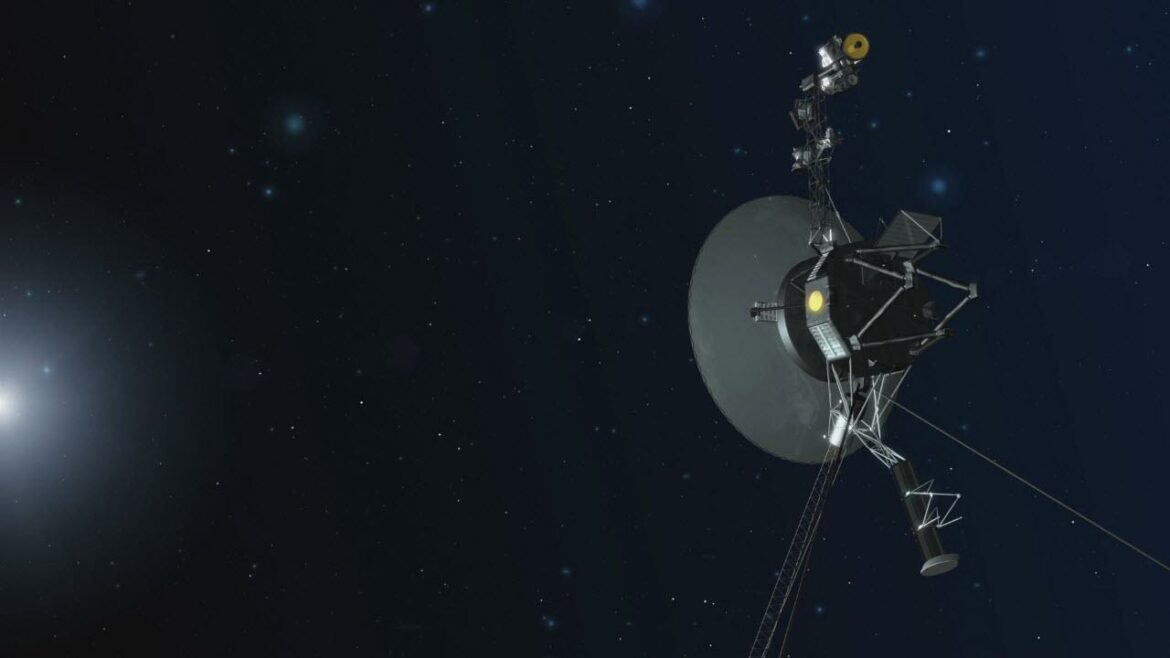Voyager is a spacecraft launched by NASA in 1977, with the twin goals of studying Jupiter and Saturn. The Voyager spacecraft are currently the farthest man-made objects from Earth. As of September 2013, Voyager 1 was about 121 AU from Earth (1.8×10^9 km; 11.4 light hours), or about 18 billion miles (30 billion kilometers), and moving away from us at about 17 kilometers per second (38,000 mph). Its sister craft, Voyager 2, launched two weeks after Voyager 1, is now about 100 AU from Earth (1.5×10^9 km; 9.6 light hours) and moving away at 15 kilometers per second (34,000 mph).
The Voyagers were built to take advantage of a rare planetary alignment that occurs every 176 years; this alignment meant that for a brief period of time it would be possible for a spacecraft to visit all four gas giant planets – Jupiter, Saturn, Uranus and Neptune – using only one gravity assist from each planet. This “Grand Tour” was proposed by John Dyson in 1960 while he was working on his PhD at Cornell University under advisor Carl Sagan; Sagan later became one of the most well-known popularizers of science in history. The primary mission goal was to study Jupiter and Saturn up close; however all four gas giants were eventually visited by the twin craft.
Jupiter’s largest moon Ganymede was discovered by Galileo Galilei in 1610; it is larger than Mercury. Callisto was discovered in 1610 by Galileo as well but not identified as a satellite until 1616 when Simon Marius gave it its name which means “most beautiful”. Io is the innermost large moon of Jupiter and was discovered by Galileo Galilei on January 8th 1610 along with Europa and Ganymede making it the fourth moon known to exist orbiting another planet after Earth’s Moon Luna Callisto and Mars’ moons Phobos Deimos respectively . Europa is slightly smaller than our own Moon with a diameter 3122km compared to Luna’s 3476km yet it has twice as much water ice covering its surface than there is water on Earth making it an enticing target for future colonization .
It wasn’t until 1979 when Voyager 1 made flybys past Jupiter did we get our first decent look at these enigmatic worlds thanks largely due to advances in technology since their initial discovery almost 400 years prior . Images returned showed not only volcanic activity on Io but also what appeared to be an ocean beneath Europas frozen surface further increasing interest in these distant worlds .
Saturn’s largest moon Titan was discovered in 1655 by Christiaan Huygens who also correctly deduced that Titan orbited Saturn rather than being stationary like stars as previously thought . It wasn’t until 2004 when Cassini made detailed observations during numerous flybys that we began unravelling Titans secrets such as the fact that it possesses an atmosphere thicker than that of our own home world which likely contains methane rain clouds very similar to those found here on Earth some 4 billion years ago before life began altering our atmospheric composition . Enceladus another one of Saturns many moons also revealed itself to be an amazing place worthy of further exploration when Cassini observed geysers spewing material including water vapor out into space from cracks near its south pole thus indicating the presence of liquid water underneath its icy surface once again raising tantalizing questions about habitability beyond our home world .


